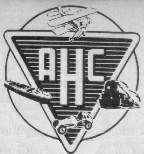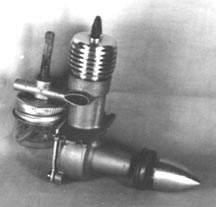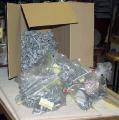The AHC Diesel Project

Created: May 2001
Last Update: July 2007
Click on images for larger picture
 20th Century: Background and History
20th Century: Background and History
 21st Century: Prototype and Fixtures Development
21st Century: Prototype and Fixtures Development
 Production: Australia
Production: Australia
 Variations:
Variations:
 Red Racer
Red Racer
 Black Magic
Black Magic
History
Founded in 1931, America's Hobby Center (AHC) became one of the biggest names in the Golden Age of Model Aircraft. The main headquarters was on West 22nd Street in New York. I visited there in 1970 and lived (it was daytime). AHC operated a shop front, warehouse and major mail-order dispatch operation for decades, at one time boasting two NY locations with offices in Chicago and Los Angeles. They offered all types of models and related equipment at discount prices, running multi-page adds in all the main American model magazines. The operation spanned nearly 70 years, ignominiously filling Chapter 11 in September 2000. There are many "stories" of AHC, it's business ethics and the Winston brothers who owned and ran it, but say what you will, along with the ones shamelessly burnt, they also had countless thousands of satisfied customers, world wide.
It would not be unfair to say AHC was in the forefront of "slag" engine production during the ignition era—engines like the Thor, Genie, and Buzz series. Now just because an engine is designated "slag", that does not mean it is necessarily a dud—it just means that the materials used were not of the highest quality (but, yes, some had performance to match!) For example, under AHC, the well designed Loutrel became the infamous "GHQ" of steadily declining quality. Around 1945, AHC embarked on a new engine project, commonly called the AHC Diesel. This engine, designed by Bernie Winston, may have been a response to the Deezil (note the cute spelling) being mass marketed by rival "Gotham Hobby" (two more Winston brothers and former share holder/partners in AHC, reputedly not allowed "back in" on return from service after World War II). Even though it was announced, the project was never brought to market.
 The photo here is the only known shot of the prototype engine. It shares the needle valve assembly with another AHC slagger, the "Genie". The tank—actually a small, glass, screw top jar—would appear to be from the same source. With a capacity of about 2cc, the design is a conventional side-port, compression ignition engine. It's unique features are the complex, die cast crankcase with a long, delicate, cast-in venturi and a backplate that was to be stamped from 1/16" aluminium.
The photo here is the only known shot of the prototype engine. It shares the needle valve assembly with another AHC slagger, the "Genie". The tank—actually a small, glass, screw top jar—would appear to be from the same source. With a capacity of about 2cc, the design is a conventional side-port, compression ignition engine. It's unique features are the complex, die cast crankcase with a long, delicate, cast-in venturi and a backplate that was to be stamped from 1/16" aluminium.
 In fact, the project had reached an early stage of production, including manufacture of a die and the first run of about 500 die cast crankcases from a material of non-specific ancestry. Exactly why it died is not known today, but the cases and presumably the drawings passed through a number of hands in the intervening years, one of whom was Motor Boy Tim Dannels, editor of ECJ. From Tim, I obtained a crankcase and what remained of the drawings. There do not appear to be any circa 1940 drawings remaining. One, the backplate stamping, carries the date "Jan 24, 1977"; the others are by a different draftsman and are undated and are of unknown origin, accuracy and fidelity to whatever originals once existed. Using these and some information from Russell Watson-Will, the engine was redesigned under CAD with input from two stroke porting experts, Ken Croft (England) and David Owen (Australia). Bert Striegler (Texas) built a prototype and found it to be an easy starting, well behaved engine of adequate if not outstanding performance. That's Bert's good-looking prototype pictured here.
In fact, the project had reached an early stage of production, including manufacture of a die and the first run of about 500 die cast crankcases from a material of non-specific ancestry. Exactly why it died is not known today, but the cases and presumably the drawings passed through a number of hands in the intervening years, one of whom was Motor Boy Tim Dannels, editor of ECJ. From Tim, I obtained a crankcase and what remained of the drawings. There do not appear to be any circa 1940 drawings remaining. One, the backplate stamping, carries the date "Jan 24, 1977"; the others are by a different draftsman and are undated and are of unknown origin, accuracy and fidelity to whatever originals once existed. Using these and some information from Russell Watson-Will, the engine was redesigned under CAD with input from two stroke porting experts, Ken Croft (England) and David Owen (Australia). Bert Striegler (Texas) built a prototype and found it to be an easy starting, well behaved engine of adequate if not outstanding performance. That's Bert's good-looking prototype pictured here.
 Through our interest in the engine, we discovered that once again, a current owner had decided to dispose of the project. The Motor Boys have previously agreed that we are not in the engine making business, but that's not to say that some of us are not too young and stupid to think about it individually (Question: What's the only way to make a small fortune manufacturing model engines? Answer: Start with a large one!). So the project has changed hands again and this time, it has been split three ways with parts going to Canada, England and Australia. The current plan will see some engines produced to a common baseline, but probably with minor variations, at three locations and no fixed timetable. So when and how they will reach the market is about anyone's guess at this stage. However, when (and if!) they do, they will all be genuine, since there's no originals for them to be copies or reproductions of!
Through our interest in the engine, we discovered that once again, a current owner had decided to dispose of the project. The Motor Boys have previously agreed that we are not in the engine making business, but that's not to say that some of us are not too young and stupid to think about it individually (Question: What's the only way to make a small fortune manufacturing model engines? Answer: Start with a large one!). So the project has changed hands again and this time, it has been split three ways with parts going to Canada, England and Australia. The current plan will see some engines produced to a common baseline, but probably with minor variations, at three locations and no fixed timetable. So when and how they will reach the market is about anyone's guess at this stage. However, when (and if!) they do, they will all be genuine, since there's no originals for them to be copies or reproductions of!
As you may have guessed by now, the Australian third of the project now takes up space under my bench. This set of pages descries the process of developing a prototype, a few engines for friends and sale, plus variations on the theme with different induction systems. A spark ignition engine is another possibility, as is the AHC Diesel kit: a crankcase and a set of plans for amateur constructors.
![]()
